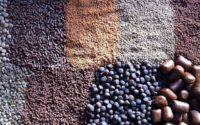Saline Agriculture Market Analysis, Trends & Industry Forecast to 2026
Advancing agriculture sector is driving the growth of the global saline agriculture market in the forecast period, 2022-2026.
Global Saline Agriculture Market is expected to project an impressive growth in the forecast period, 2022-2026, with an impressive CAGR on the account of surging demand for the higher-yielding food crops. The rapidly rising global population is also driving the growth of the global saline agriculture market in the upcoming five years. Due to scarcity of food in the world and increasing demand for food are major reasons responsible for the future growth of the global saline agriculture market in the next five years. Technological advancements and extensive research towards enhancing the quality and quantity of the food crops are also aiding the growth of the global saline agriculture market in the future five years.
The major factors driving the growth of global saline agriculture market include reducing freshwater resources, increasing global food demand, among others.
Continuous increase in the sea level is increasing salinization in the North Sea region. This increases the seepage of seawater; a higher risk of flooding increases the salinization of farmland in the region and thus substantiates the growth of the global saline agriculture market in the forecast years. Saline agriculture also improves and enhances the re-use of degraded farmland and further aids the growth of the global saline agriculture market in the forecast period, until 2026.
Browse Full to Read:
https://www.techsciresearch.com/report/saline-agriculture-market/7996.html
The global saline agriculture market is segmented on the basis of water source, technology, crop type, application, competitional landscape, and regional distribution. Based on water source, the market is further fragmented into seawater, brackish water, sewage, and others. Seawater is anticipated to register the largest revenue shares of the market and dominate the segment in the upcoming five years on the account of advantages of seawater for the saline agriculture. With increasing sea level and climatic changes, the growth of the market segment is further aiding the growth of the global saline agriculture market in the next five years. Brackish water is also expected to register significant growth in the future five years on the grounds of its application for the saline agriculture. Brackish water can be directly used for the irrigation in the absence of fresh water. Seed irrigation through brackish water is not advised. Rotated interval irrigation with brackish and fresh water can be used with brackish water for salt-tolerant crops or crops at the salt-tolerant growth stages and fresh water for salt sensitive crops or crops at salt sensitive growth stages.
On the basis of technology, the market is segmented into saltwater aquaponics, saltwater hydroponics, saltwater greenhouse, and others.
High yielding halophytes followed by oilseeds are majorly grown crop type grown using saline agriculture.
Saltwater aquaponics is a combination of plant cultivation and fish rearing. In countries like Japan, saltwater species are much more popular than the freshwater fishes. The saltwater fish species add to the nutrient level of the saline water and supports the agricultural fields, thereby substantiating the growth of the global saline agriculture market in the forecast years. Saltwater hydroponics do not grow the plants in seawater but creates a possibility that the water derived from the sea is somehow utilized in the hydroponic system. In the hydroponic system, sea water is captured, and nutrients are derived out of it, then fresh water is utilized for the irrigation while supplying the derived nutrient from the seawater to replenish the plants growing inside the setup.
Industry Players:
- Seawater Solutions,
- Seawater Greenhouse,
- Agrisea, Seagrass Tech Private Limited,
- Smart Floating Farms,
- Blubrim Systems,
- Red Sea Farms,
- Salt Farm Texel, etc.
Rising Global Population Supports Saline Agriculture Market Growth
Current global population count is almost 8 billion in the year 2021. The demand to feed the rapidly increasing global population is driving the growth of the global saline agriculture market in the upcoming five years. The countries that are draught struck for a major part of the year like Uganda, Morocco, Somalia, etc. are living under the severe demands for the food crops but they have to be dependent on the neighboring countries for the food supplies. Saline agriculture is supporting the food security, thus supporting the countries supplying food to these countries which aids the growth of the global saline agriculture market. Countries like China, United States, and Pakistan have 15%, 27%, and 20% of irrigated land that prosper the irrigation through saline water.
“Asia Pacific region is expected to dominate the market during forecast years due to high dependency of countries like India, China, and Japan over the agriculture sector to enhance their economic standards. Advancements in the agricultural practices are actively incorporated in these countries and these innovations are supporting the growth of the global saline agriculture market in the upcoming five years. The demand to feed the ever-increasing population of China and India is aiding the demand and the market growth in the future years. Countries like India, Thailand, and Malaysia are surrounded by sea lines. Availability of saline water, and salt soils is also demanding active utilization of saline agriculture to increase the higher yields of the crops. New market players are advised to invest in the extensive research and innovative agriculture practices along with alternate techniques in irrigation of crops, fertilization, and water management such that their brand establishment and consumer demands are well satisfied,” said Mr. Karan Chechi, Research Director with TechSci Research, a research based global management consulting firm.
Climatic Change Threatens Global Food Security
For sustainable agricultural productions, a salinity balance has to be maintained at the irrigation and basin levels. Conjunctive use, water table management, rainwater conservation, and chemical amelioration are some of the important practices that aid the sustainable agricultural productions and thereby support the growth of the global saline agriculture market in the next five years. Climatic changes and rising sea levels are increasingly causing the saline water to penetrate agricultural soils and substantiating the growth of the global saline agriculture market in the future five years. Climate change is a global concern and the changes cause concerns for the agricultural practices in coastal areas. Saline agriculture has made it possible for the coastal areas to produce food crops of the non-salt sensitive crops in the area, supporting the growth of the food crops in the saline soils, thus further aiding the growth of the global saline agriculture market in the upcoming five years.
What are the major factors driving the growth of global saline agriculture market?
The major factors driving the growth of global saline agriculture market include reducing freshwater resources, increasing global food demand, among others.
What is the major crop type grown using saline agriculture?
High yielding halophytes followed by oilseeds are majorly grown crop type grown using saline agriculture.
Who are the major players operating in the global saline agriculture market?
The major players operating in the global saline agriculture market includes Seawater Solutions, Seawater Greenhouse, Agrisea, Seagrass Tech Private Limited, Smart Floating Farms, among others.
What are the factors hampering the growth of global saline agriculture market?
The major factors hindering the growth of global saline agriculture market include lack of awareness and lack of adoption of the practice especially in developing and emerging countries.
Contact
Mr. Ken Mathews
708 Third Avenue,
Manhattan, NY,
New York – 10017
Tel: +1-646-360-1656
Email: [email protected]



